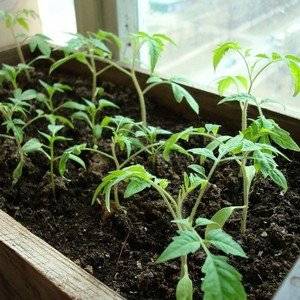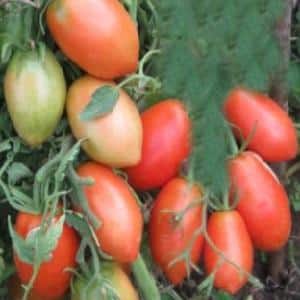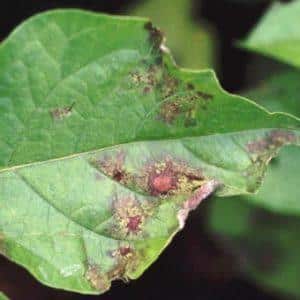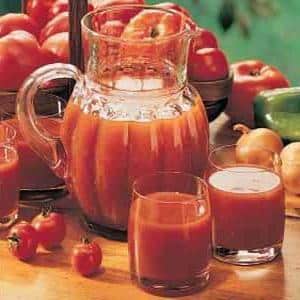A combination of the best qualities of tomatoes in one variety - the “Dusya Krasnaya” tomato: reviews, photos and growing secrets
Tomatoes can improve mood and reduce stress. Especially when it comes to sugary and sweet vegetables. One of these varieties is Dusya red. The hybrid is characterized by stable yield and beautiful appearance. Red dusya is actively used in cooking and folk medicine. Let's look at what other advantages the hybrid has and how to get a harvest of beautiful and appetizing tomatoes.
Description of the variety
The Dusya red tomato shows the best results in greenhouse conditions, but many people plant it in the open air. Tomatoes are grown by seedlings, the first harvest is obtained within 90-100 days from the moment of planting. Mid-early tomatoes are planted both in the south of the country and in the northern regions. As befits a hybrid, this variety is highly resistant to bad weather and disease.

Distinctive features
The height of the bush varies from 80 to 150 cm. The variety is unpretentious in care, but requires timely gartering and pinching. The clusters are medium leafy; 4-7 tomatoes are produced on one plant. Externally, the leaves are similar to potato leaves, dark green in color.
Characteristics of tomatoes and yield
Dusya red has an oval shape and a rich bright color. Externally, the tomato resembles a bell pepper. The pulp is dense, there are few seed chambers. The weight of one vegetable is about 200 g. The variety is universal in use and is valued for its high taste. From 1 sq.m, gardeners harvest about 7 kg of beautiful and neat tomatoes.
How to grow seedlings
Red Dusya seedlings are prepared 50-60 days before planting the plants in the ground. During this time, the sprouts get used to external conditions and adapt to the air temperature. The germination of seedlings largely depends on the quality of the seeds and soil.
Seed preparation
 Before planting, seeds must undergo careful selection. First of all, inspect them for external abnormalities. If you notice damage or spots on the surface, do not plant the seeds. Choose only healthy and even seed. We also recommend that you carefully read the information on the packaging and trust only trusted manufacturers.
Before planting, seeds must undergo careful selection. First of all, inspect them for external abnormalities. If you notice damage or spots on the surface, do not plant the seeds. Choose only healthy and even seed. We also recommend that you carefully read the information on the packaging and trust only trusted manufacturers.
After selection, the seeds are disinfected. To do this, place them in the sun for a week, for example, on a windowsill or balcony. The sun's rays will warm them up from all sides and destroy pathogens on the surface.
After disinfection, the seeds are germinated. Wrap them in a damp cloth and place them on a plate. It is advisable to germinate in a bright and warm place. This procedure improves the germination of the material and strengthens its immunity. For better results, gardeners add Epin or Mortar to the liquid. Growth stimulants accelerate the development of tomatoes.
It will be interesting:
Container and soil
 For seedlings, any clean and dry container is suitable, for example, plastic glasses or a wooden box. The most popular are plastic cassettes, which can be purchased at any gardening store. Their value lies in the fact that they are convenient when transplanting seedlings into the ground.
For seedlings, any clean and dry container is suitable, for example, plastic glasses or a wooden box. The most popular are plastic cassettes, which can be purchased at any gardening store. Their value lies in the fact that they are convenient when transplanting seedlings into the ground.
Many gardeners prefer to prepare the soil for seedlings themselves. For this you need soil from the garden, humus, peat and river sand. The main thing is to remember that such soil must be disinfected with a solution of potassium permanganate.
Important! If you don’t want to spend time and effort preparing the soil, ready-made “Universal” or “Strong” soils will come to the rescue. They are affordable and already contain all the necessary nutrients for the development of sprouts.
Sowing
Pour soil into a container and pour plenty of warm water over it, leave for six hours.. Then make grooves 1 cm deep in the ground and place the seeds in them. Sprinkle soil on top and moisten again. It is recommended to cover the seedlings with glass or film and remove them after the first shoots appear.
Growing and care
Caring for seedlings does not require special effort or special knowledge. The main thing is to follow the watering regime. Moisten the seedlings every 7-10 days. It is important to prevent the soil from drying out and not to over-wet it. It is recommended to use a pipette or syringe for watering so that the water gets directly under the root, bypassing the stems and leaves. Remember that excess moisture increases the risk of developing fungal diseases.
Important! Grow seedlings in a warm and bright place. Avoid drafts and be careful with air conditioning.
The ideal air temperature for seedlings is at least 20 degrees. If the plant does not have enough light, use additional lighting with fluorescent lamps. Two weeks after planting, organize the first feeding. Liquid bird droppings and ash solution are excellent fertilizers.
How to grow tomatoes
After two months, the seedlings are transplanted into the garden. The best place for tomatoes is light and windless areas that are located away from ponds and underground groundwater.
Landing
They are preparing for planting in the fall.. Be sure to dig up the beds and remove all debris and weeds from them. Fertilize the soil with liquid manure. With the arrival of spring, dig up the soil again and water it with Bordeaux mixture. The mixture will disinfect the area and destroy dangerous microorganisms.
Plant red Dusya at a distance of 50 cm from each other. We recommend installing wooden stakes next to each sprout to which adult bushes will be tied. After planting the seedlings in the ground, water the beds generously with warm water. The next watering will be only in 10 days.
Care
In the future, tomatoes are moistened every 8-11 days. The frequency of watering depends on weather conditions. If the summer is dry and hot, plants need more water. However, do not flood the beds: this may cause the tomatoes to crack. Many gardeners use a drip system because it helps control water flow and is suitable for applying liquid root fertilizers.
 Dusya red needs timely fertilizers. The most common ones are:
Dusya red needs timely fertilizers. The most common ones are:
- manure or droppings;
- ammonium nitrate;
- nitrophoska;
- nettle based solution;
- ash solution;
- yeast;
- Bordeaux mixture.
Apply fertilizer every two weeks. It is best to alternate organic fertilizers with mineral ones. Be especially careful with nitrogen-containing substances, as an excess of them will only harm the tomatoes.
Important! Do not forget about loosening the soil and removing weeds. Loosening improves oxygen access to the roots, and removing weeds is necessary to maintain the necessary microflora in the beds.Carry out these procedures every week.
Features of cultivation and possible difficulties
The variety requires mandatory formation. Form Dusya red into one stem, removing all lateral shoots and shoots. When forming, the main thing is not to harm the bush; the stepsons are cut off carefully. Formation and pinching are necessary to ensure that leaves and shoots do not obscure sunlight.
Gardeners also face difficulties in applying fertilizers incorrectly.. For example, if you add ammonium nitrate or urea in excess, yellow spots will appear on the leaves and the plant will begin to dry out. This occurs due to an excess of nitrogen. In this case, gardeners advise watering the beds abundantly and laying straw on them.
Read also:
Advantages and disadvantages of the Raspberry Elephant variety
“Little Red Riding Hood” tomatoes, popular among summer residents
Diseases and pests
 The most common attack on tomatoes is late blight.. This is a fungus that enters the plant through the stomata and spreads throughout the stem. Late blight can live in both soil and seeds. The fungus appears in the form of brown spots and wilting. To prevent infection, treat the bushes with soapy water or ash. In addition to late blight, tomatoes suffer from root rot, which ash also helps fight.
The most common attack on tomatoes is late blight.. This is a fungus that enters the plant through the stomata and spreads throughout the stem. Late blight can live in both soil and seeds. The fungus appears in the form of brown spots and wilting. To prevent infection, treat the bushes with soapy water or ash. In addition to late blight, tomatoes suffer from root rot, which ash also helps fight.
The most dangerous pest is the Colorado potato beetle.. An insect familiar to many from childhood infects the leaves, causing them to become dry and dark spots to appear. That is why it is not recommended to plant tomatoes next to potatoes, and even more so in the beds where potatoes were once planted. It is preferable to fight the Colorado potato beetle with the help of professional preparations “Typhoon” or “Killer”.If the plant is being destroyed by whiteflies or aphids, spray with copper sulfate.
The nuances of growing in open ground and greenhouses
When growing Dusya red in a greenhouse, pay special attention to tying the bushes to the support. In addition to the traditional method of tying to wooden stakes, gardeners actively use the Maslov method. On a thick fishing line, knots are tied every 20 cm. Next, the fishing line is cut into sections the height of the greenhouse and attached at the top opposite each bush. Using wire hooks, the tomato is tied to a fishing line and hung from the nearest loop. Maslov's method is very convenient and practical.
If you grow tomatoes in open ground, do not forget about the temperature regime. If the summer turns out to be foggy and cold, build caps for the bushes from thick film. They will help the plant survive unfavorable climatic conditions. The caps are easy to use: as soon as the weather returns to normal, they can be easily removed from the bush. This technique is especially relevant for gardeners from northern regions.
Harvesting and application
 Harvested as they ripen. The yield of the variety is friendly, the tomatoes ripen on the bunch at the same time. Dusya red also ripens well in indoor conditions. Harvest ripe tomatoes immediately, do not allow them to overripe. This harms the entire bush.
Harvested as they ripen. The yield of the variety is friendly, the tomatoes ripen on the bunch at the same time. Dusya red also ripens well in indoor conditions. Harvest ripe tomatoes immediately, do not allow them to overripe. This harms the entire bush.
The variety is used in the preparation of various dishes. Red Dusya is great for summer salads, combined with cucumbers and bell peppers. The sweetish taste of the vegetable adds piquancy to the dish. Tomato is also suitable for soups, such as borscht or kharcho. In addition to taste, tomatoes give dishes an appetizing scarlet color.
Thanks to the high content of vitamins and macroelements tomatoes are used for preparing dietary food.They are used to make low-calorie purees, salads, cold appetizers and sandwiches. Red Dusya goes well with various sauces and spices.
Interesting! Housewives love to make tomato juice. Its taste and benefits are undeniable; it saturates the body with vitamins. For cooking, in addition to tomatoes, you need salt and sugar to taste. Cinnamon, basil or garlic are also often added to the drink.
Advantages and disadvantages of the variety
The advantages of Red Dusya, gardeners primarily include its unusual appearance.. Due to its size and shape, the tomato is used as a base for stuffed dishes. The vegetable is also valued for its pleasant taste and tender pulp. Red Dusya is universal in use and rich in useful substances. In addition, the variety is characterized by excellent yield and immunity to diseases and pests.
Among the disadvantages, the need to form a bush is noted. Gartering and pinching require additional effort and time, which is not always convenient.
Farmer reviews
Gardeners' opinions about the Dusya Krasnaya variety are contradictory: some find it attractive and tasty, while others do not find it so impressive.
 Elena, Tver: “Dusya red is one of my favorite varieties. It is very tasty, the pulp literally melts in your mouth. I use it in a variety of forms: I make preparations, salads, and snacks. But the variety is also good fresh. I recommend to all".
Elena, Tver: “Dusya red is one of my favorite varieties. It is very tasty, the pulp literally melts in your mouth. I use it in a variety of forms: I make preparations, salads, and snacks. But the variety is also good fresh. I recommend to all".
Marina, Moscow: “Dusya Krasnaya planted tomatoes for the first time, and overall she was pleased with the result. The yield is good, as is the quality of the tomatoes. I planted it using seedlings and there were no problems with care.”.
Evgeniy, Penza: “I expected big and beautiful tomatoes from Dusya red, like on the packaging. The end result was tomatoes of medium size and watery taste.I planted it in a greenhouse and fertilized it on time. I'll try to plant again next year. But this time I'm disappointed".
Conclusion
There are about 10,000 varieties of tomatoes in the world! Each of them has its own taste, appearance and secrets of a successful harvest. For example, Dusya red has an interesting shape and sweet taste, and for a rich harvest it needs fertile soil, timely watering and fertilizing. Tomatoes are used not only in cooking, but also in cosmetology, for example, they make nourishing face masks based on cottage cheese and tomatoes.
What nonsense has been written. And it’s clear that there are only 4-7 fruits on the plant and that this tomato needs to be grown in 1 trunk. Do you read this yourself?